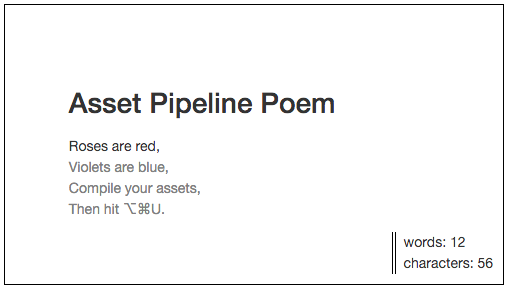 Asset Pipeline Poem
Asset Pipeline Poem
Reflection
This training helped identify how assets weave together into a Rails app and as well as some of the structure I need to be aware of. It makes a lot of sense especially after the lecture but, as always, walking through it to see the steps is really important in solidifying the concepts. I now has a good reference point in how I need to structure and order my assets so my content displays in the way it's intended. It was fun!
Objective: Practice requiring CSS and JavaScript files in the Rails asset pipeline and precompiling assets.
Terms:
- Manifest
- Precompilation
- Concatenation
- Compression / Minification
- Browser Caching
- MD5 fingerprint
Ode to the Asset Pipeline
Your goal is to reconstruct a simple poem. To get started:
- Clone this repo, and take any steps necessary to get the app running on your computer.
- Note that this Rails app doesn't have a database.
- Start your server, and navigate to
localhost:3000in the browser. You should see a jumbled poem.
The poem should eventually look like this when you're done making changes:
Rules
- You are not allowed to modify any files except
app/assets/javascripts/application.js,app/assets/stylesheets/application.css, andconfig/environments/development.rb(to configure asset precompilation). - Try not to use
require_tree .anywhere.
Using the Asset Pipeline
The assets you need require will live somewhere in the following locations, inside of your Rails application directory:
app/ # application specific code
assets/
images/
javascripts/
stylesheets/
lib/ # custom libraries
assets/
javascripts/
stylesheets/
vendor/ # third party libraries
assets/
javascripts/
stylesheets/
Each directory has a specific use case. The files you want are scattered across them. Your goal is to find all the files and require them in the correct order!
A solution is in the solution branch.
Bonus: Using Third-Party Code
- Note that the Bootstrap CSS and JavaScript libraries are included in
views/layouts/application.html.erbusing CDN links. Practice requiring the files through the asset pipeline instead:
- Find and copy the current
bootstrap.cssURL (seeviews/layouts/application.html.erb). - From the Terminal, run
curl -vs BOOTSTRAP_CSS_URL_YOU_COPIED > vendor/assets/stylesheets/bootstrap.min.css - Finally, delete the CDN link from
application.html.erb, andrequirethe new Bootstrap CSS file in yourapplication.cssmanifest. - Repeat these steps for the Bootstrap JavaScript library.
- Precompile your assets.
You can also use the front-end package manager Bower to download and install library files.
- Downloading the Bootstrap CSS and JavaScript files isn't the only way to use Bootstrap with the Rails asset pipeline! You can also use the bootstrap-sass gem.
- In
application.cssandapplication.js, remove therequirestatements for Bootstrap, and use the bootstrap-sass gem instead (follow the installation steps in the docs). - After installing bootstrap-sass, precompile your assets again.
It's often easier to use a well-documented gem than to to work directly with the asset pipeline. Watch out for gems that haven't been updated in a while, though, or for bad interactions among gems.
A solution for this bonus is in the solution_bootstrap_sass branch.
